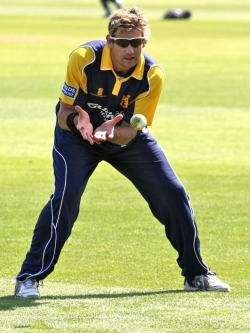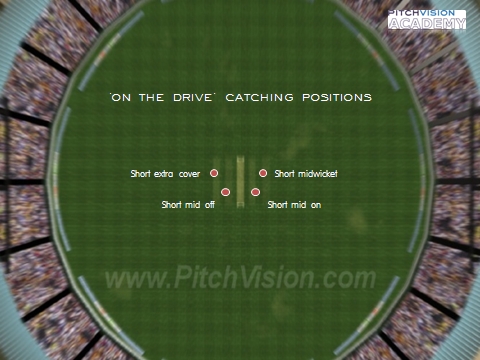Specialist Fielding: Catching on the drive

This is part of the specialist fielding series of articles, for the full list of fielding positions covered click here.
Go to any professional level one day game and you’ll see one position that has become ubiquitous: Short midwicket.
But it’s not just pyjama cricket where the fielder ‘on the drive’ is useful and it’s seen more at every level of the game anywhere from mid on to midwicket and mid off to extra cover.
Why have a fielder on the drive?
The first is to catch and stop balls that are driven by the batsman the same way a goalkeeper would try and save a penalty.
The second is to act as a distraction and prevention of tip-and-run tactics by a batsman who is tied down and needs to keep the scoreboard ticking.
Run out chances may also come along if the batsman misjudges. One thing this position is not for is the bad-pad catch. You will never be close enough to take those.
A good drive fielder then needs sharp reflexes, safe hands and an accurate throw from a quick pickup or even following a diving stop.
There are many similarities with gully in this respect and it’s often the case that a good gully fielder makes an excellent drive fielder (and vice versa).
The position is especially useful on pitches that are slow as the ball will not carry to traditional slips. It’s also a handy position on true pitches against batsmen who like to drive ‘on the up’ and are more likely to drive in the air.
How to field on the drive
The drive position covers a relatively wide area. You could find yourself anywhere from just next to the cut strip to a extra cover or midwicket.

How deep you stand depends on the pace of the wicket and the power of the batsman but you will be closer than an orthodox ring fielder but not as close as a ‘silly’ close catcher or short leg. Usually this will be 10-15m from the stumps.
The rule of thumb is to get as close as you can but still be able to stop a drive off the middle of the bat. As you field more in this position you will get a feel for how close you can get.
Technically this position is most like slips and gully. Your stance should be similar; body relaxed but ready to move quickly and eyes concentrating.
Watch the batsman as he will shape early to play the shot that will bring the ball your way (a front or back foot drive). When you see him moving, focus your attention on the bat, then when he hits it try and pick up the ball as early as possible. This tactic gives you the best chance of taking the catch.
Disrupting the batsman
You also have a key role to play as a distraction to the batsman, disrupting his concentration.
Simply by being there is usually enough. You are in the batsman’s eye line and his mind. But if you can also chip in with a few choice comments to the wicketkeeper you can add to the overall feeling of ‘surrounding’ the batsman.
Don’t fall into the ineffective trap of continual swearing or insulting the batsman. Apart from being against the spirit of the game it rarely works. Good sledging is about picking the right moment, saying the right thing and being as original as you can be.
A great example was in a game I played recently when the batsman was playing a slow innings and not looking to rotate the strike or score boundaries. He was blocking everything basically. I was keeping wicket and the short extra cover called my attention:
“I thought bats came pre-knocked in these days.” He said loud enough to be heard.
A few balls later the batsman tried a big drive and hit it straight into the hands of the same fielder. Game, set and match.
How to practice fielding at short midwicket/short extra cover
Being on the drive is not like being in the slips; it tends to be a less used position. For this reason it’s best to double up your practice with gully and slips so you can perform any of the three.
Make sure you are doing this drill at every practice as it is especially good for close catching on the drive. Work on your reactions and concentration every day, even if you are not practicing.
The drive fielder on either side is not a position for the faint-hearted. You are staring down the barrel of a gun. To be effective you have to stand firm and be confident through lots of practice.
- Login to post comments

